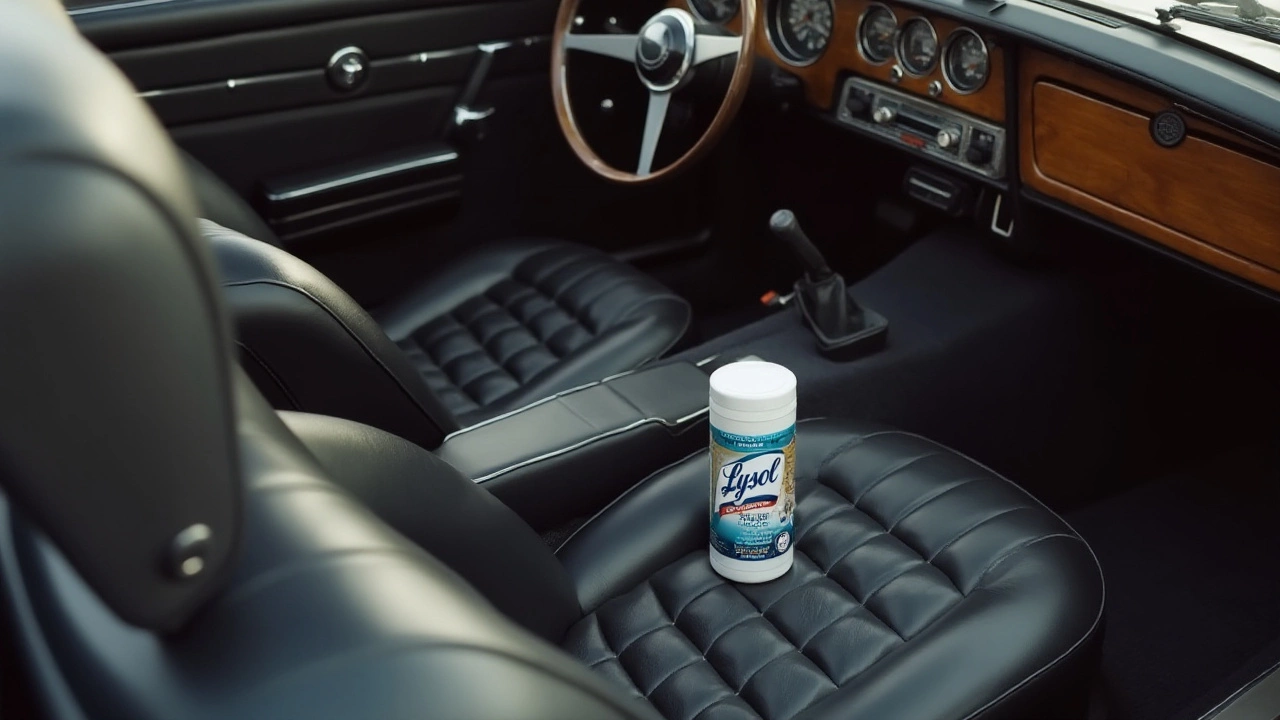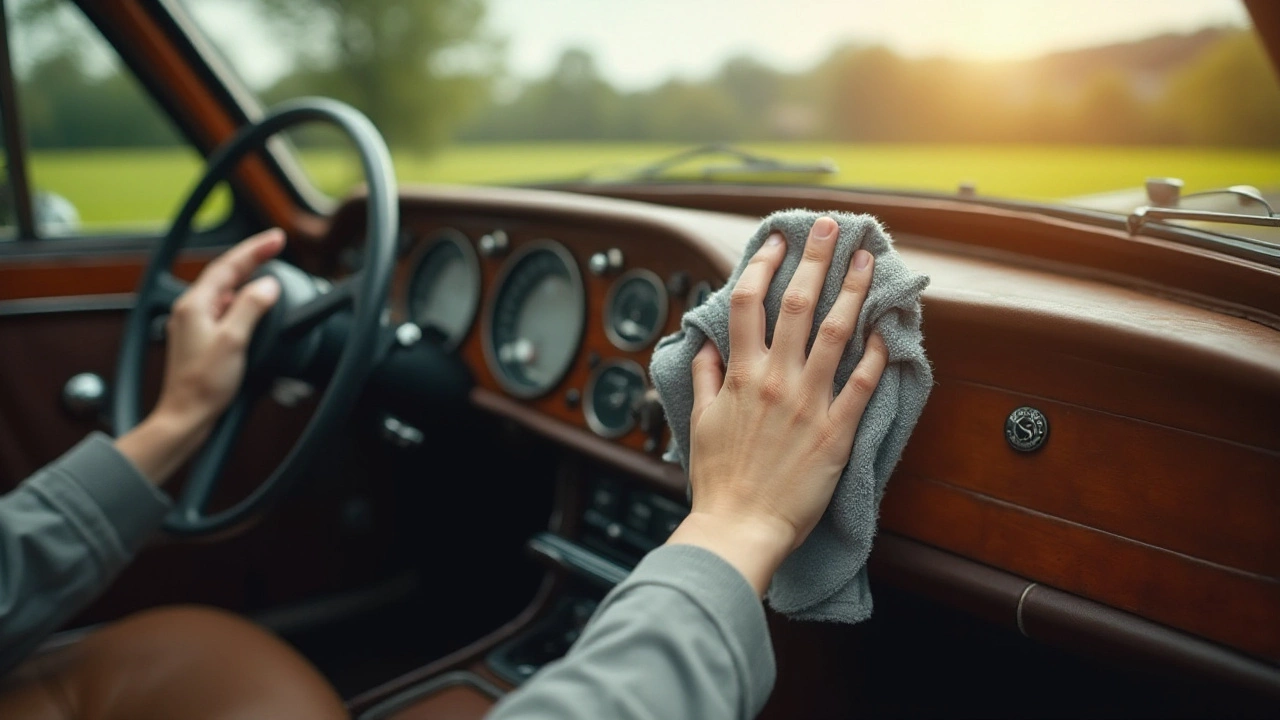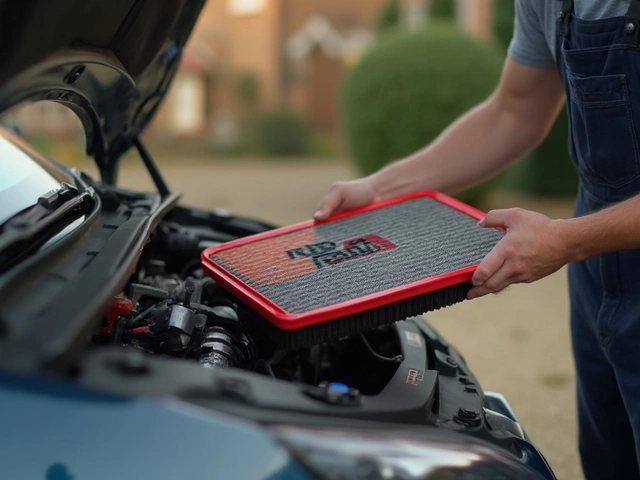When it comes to keeping your car's interior clean, grabbing a pack of Lysol wipes might seem like the ideal solution. They're easy to use, convenient, and effectively disinfect surfaces. But there's a catch when it comes to using them in your car—knowing what they're safe on and what they might harm.
Your car's interior is composed of a variety of materials ranging from leather to plastic, fabric, and metals. Each has its own cleaning needs and tolerances. Understanding which materials can safely meet Lysol wipes will save you from any unpleasant surprises, like discoloration or early wear.
Beyond just cleanliness, it's crucial to understand how to protect the delicate fabrics and surfaces while ensuring germs have no place to hide in your vehicle. Read on to arm yourself with the knowledge of how to clean smarter, not harder, while maintaining the luxurious feel of your car's interior.
- Introduction to Lysol Wipes
- Materials in Car Interiors
- Benefits of Using Lysol Wipes
- Potential Risks and Precautions
- How to Use Safely
- Alternative Cleaning Methods
Introduction to Lysol Wipes
Lysol wipes have become a household staple for quite a few years now. Whether you're trying to keep your home pristine or ward off germs during flu season, these wipes offer a quick and easy solution for surface cleaning. Originally developed as a disinfectant spray in the late 1800s by Dr. Gustav Raupenstrauch, Lysol evolved to what we know today as a convenient wipe format. Though they were initially created to combat cholera, Lysol products have found their place in modern society for general cleaning due to their ability to kill 99.9% of viruses and bacteria.
The ease of use contributes significantly to their popularity. You don't need a spray bottle or towel; just grab a wipe and get going. This convenience, however, does not come without questions, especially concerning the wipes' compatibility with different surfaces. Understanding the actual composition of these wipes can help make informed decisions, ensuring you use them correctly. Each Lysol wipe is soaked in a potent solution containing ethanol, alkyl dimethyl benzyl ammonium chloride, and other agents known for their disinfecting properties. These ingredients are effective but also surprisingly complex, thus making it essential to understand their effects on various materials before application.
According to a study published in the Journal of Hospital Infection, disinfecting wipes like Lysol are particularly effective for quickly reducing bacterial load. But the key is in their proper use. As Dr. Karen Smith, an expert in microbiology, mentions, “The disinfecting efficacy of wipes is markedly reduced when users do not consider the material surface compatibility.”
“While these wipes are highly effective, ensure that you're not cleaning porous surfaces with disinfectant wipes intended for non-porous surfaces,” Dr. Smith suggests.This insight hints at why you should know what surfaces in your car they work best on.
Materials in Car Interiors
When you look around the inside of your car, you'll notice a complex tapestry of materials. Understanding these materials is key when it comes to cleaning and maintaining them. Let's think about your dashboard first. Primarily made from plastics or synthetic compounds such as vinyl, these materials are designed to withstand various environmental factors like heat and sunlight. These plastics, while durable, can be sensitive to certain chemicals, which makes choosing the right cleaning product crucial.
Seats offer another layer of complexity with several possible materials. Leather is often chosen for its luxurious look and feel. However, genuine leather is porous, which makes it breathable yet sensitive to excessive moisture or harsh chemicals. Using Lysol wipes repeatedly on leather could potentially strip the natural oils, leading to dryness and cracking. Fabric seats, on the other hand, usually consist of materials like polyester which are more forgiving, but they too can suffer from discoloration if exposed to strong cleaners frequently.
The trim and accent pieces, which might be metallic or wooden, also require careful consideration. Metal finishes, whether anodized aluminum or chrome, are durable yet can fall victim to pitting and tarnishing over time if cleaned improperly. Wooden trims, though rare, are typically treated with a coating which might be dulled by inappropriate cleaning agents. These materials, alongside the broader layout of your car's interior, are designed not just for aesthetics, but for functionality and durability against typical wear and tear. Yet, they require personalized care, particularly when considering frequently applied cleaners like Lysol wipes.
"Every car interior tells a tale. Not just of design, but of engineering resilience," shares automotive interior specialist, Alex Morgan.
Even small sections or overlooked areas, such as the gearshift cover or the delicate stitching in the upholstery, play a role in the broader picture of car care. They are part of a meticulous balance of textures and colors, designed to create a comfortable yet striking environment. Over time, all these elements work in harmony to provide safety, comfort, and style. However, maintaining them requires a gentle touch and informed choices about the products we use.
| Interior Material | Common Composition | Sensitivity to Cleaners |
|---|---|---|
| Dashboard | Vinyl, Plastic | Moderate |
| Seats | Leather, Polyester Fabric | High |
| Trim | Metallic, Wood | Moderate to High |
Each section of your vehicle's interior, from carpeted floors to ceiling liners, contributes to a safe and pleasant driving experience. Keeping them in prime condition involves understanding their vulnerabilities so that when you reach for those cleaning supplies, you’re armed with not only a cleaner but also the knowledge to use it wisely and sustainably.

Benefits of Using Lysol Wipes
Imagine you're getting into your car, ready to take a drive, and you're hit with the faint scent of cleanliness that signifies a well-maintained vehicle. That's the magic of using Lysol wipes on your car's interior. They offer more than just a quick swipe; they provide a level of cleanliness that is crucial for both health and aesthetics. One of the key benefits is their germ-killing ability, which is critically important in today’s health-conscious world. Lysol wipes are proven to eliminate a wide array of bacteria and viruses, including some of the more stubborn strains that live on surfaces for hours, even days. This means they do more than just clean; they make your car a safer place to be.
Another advantage is their convenience. In our fast-paced lives, the ease of pulling out a pre-moistened wipe versus preparing homemade cleaning solutions cannot be overstated. Whether it’s an unplanned spill on the dashboard or a sticky steering wheel, these wipes are ready to handle the job, no prep needed. They offer a quick fix that doesn’t involve scrubbing or soaking, saving precious time while still delivering efficiency. This is especially handy for busy parents or those with pets riding shotgun, where messes do not adhere to a schedule.
Let’s not overlook the versatility of Lysol wipes, which makes them suitable for countless surfaces within your car. From hard plastics to metals, most car interiors can safely be treated with these wipes. This versatility means that you don’t need a clutter of different products for different parts of your car. A single wipe can transition from the dashboard to cup holders and then address the gear shift without any risk of cross-contamination or chemical reaction.
"In a study conducted by the Good Housekeeping Institute, it was found that regular use of Lysol wipes significantly reduced the presence of harmful bacteria in private vehicles."
These wipes also have a drying formula that evaporates fairly quickly, which plays a pivotal role in preventing the unsightly residue that other cleaning products might leave behind. Your surfaces appear clean, dry, and streak-free, providing a shine that enhances the vehicle's looks. For those who value their car's appearance as much as its function, maintaining a streak-free shine can be a game changer.
The fragrance that accompanies Lysol wipes is worth mentioning as well. It brings a refreshing scent that masks musty odors and makes every ride a bit more pleasant. This is particularly advantageous after a rainy day or transporting pets, when your vehicle needs a bit of olfactory freshness. Different scents are available, so you have options to find what best soothes your senses and complements your vehicle's environment.
In summary, Lysol wipes not only improve cleanliness and safety; they also offer convenience and refreshment for your car interior. They’re multifunctional, user-friendly, and quick-acting, making them an invaluable tool in the ongoing battle against dirt and germs. Whether you're an individual who cherishes your car's hygiene or someone who is simply looking for efficient solution, these wipes provide numerous benefits without the hassle.
Potential Risks and Precautions
Using Lysol wipes on your car's interior might seem like a no-brainer at first, but there are a few risks you should watch out for to avoid costly damage to your vehicle. One of the main concerns with these wipes is their bleaching effect, which is usually not noticed on household surfaces but can become apparent on car materials over time. The chemicals used in these wipes can potentially cause discoloration, especially on leather seats and dashboards. The wipes often contain alcohol, which helps with disinfection but can cause the materials to dry out and crack under the relentless Australian sun, a problem that no one wants to discover after it’s too late.
For anyone who loves the soft feel of leather seats, it’s essential to be careful when choosing a cleaning method. Most car cleaning experts will warn you against using any products that are not specifically designed for automotive leather. They argue that while leather conditioner products ensure the seats remain supple and shiny, using the wrong cleaning agents can leave them rough and worn. If you are unsure about the composition of the materials in your car, it would be wise to conduct a spot test. Apply the wipe on a small, inconspicuous area to check if any adverse reactions occur.
Understanding the chemistry behind these wipes underscores the importance of proper usage. Many disinfectant products, including Lysol wipes, contain quaternary ammonium compounds. An interesting fact table below underlines their effects:
| Material | Reaction with Quats |
|---|---|
| Leather | Dried and cracked surfaces |
| Vinyl | Resistance to certain formulas |
While there are potential risks, there are also precautions you can take to minimize them. One suggestion is to avoid leaving the wipes on surfaces for too long—wipe it on, let it do its magic for a minute or two, then wipe it off with a clean, damp cloth. Another tip from car interior styling enthusiasts: ensure proper ventilation during and after cleaning. This simple step can help dissipate any potentially harmful residues.
"Cleaning your car's interior with general disinfecting wipes can lead to unwanted damage. Always check product formulations and material compatibility," advises the American Cleaning Institute.
If you find that Lysol wipes might not be entirely suitable for your vehicle's interior, consider delving into alternative cleaning solutions. A go-to home remedy is a mix of water and vinegar, which is known for being gentle on materials yet tough on grime. By taking simple precautions and understanding the makeup of cars and cleaning products, you can maintain the look of your vehicle without compromising on cleanliness. Remember, being extra cautious today could keep your ride looking fresh for years to come.

How to Use Safely
So you're ready to take those Lysol wipes to your car's interior. Before you dive in, though, let's talk about how to make sure you're doing it right. The key thing is to know the type of materials inside your car. Whether it’s leather, plastic, metal, or fabric, you should approach each differently to protect against possible damage. First things first, do a spot test. Pick a hidden area, give it a gentle wipe, and wait a couple of minutes. This ensures there’s no unexpected reaction.
Now, let's discuss leather surfaces. Most common in luxury cars or older models, leather requires special care. You need to ensure the Lysol wipes don’t dry out the leather or cause cracks. It’s smart to use them sparingly, allowing the cleaner to do its job without soaking. Following up with a leather conditioner is a fantastic way to keep it supple and looking sleek. If you have vinyl or plastic surfaces, these are usually less picky about which cleaners you use. Still, avoid excessive scrubbing—these materials can wear down, leading to a lose in shine over time.
As for fabrics, seats or floor mats that are drenched in stain potential, caution is essential. Many fabrics may react harshly to not just moisture, but the chemicals within disinfectant wipes. Following the spot test, lightly sweep over the area, and never allow the fabric to remain wet for too long. Use an ultra-absorbent cloth to instantly dry the area as soon as you finish wiping. Consider ventilating your car as well, as a circulated environment prevents mold or mildew.
Disinfecting key touchpoints, such as the steering wheel, gear shifts, and door handles may seem straightforward. Still, many overlook the small crevices and controls—those are the areas teeming with germs. Do not use excessive force that could dislodge or damage the instrument panel buttons. Be sure to double-check whether any high-touch areas have special coatings as well, to avoid defying warranties. A wise word: always have a microfiber cloth to hand. Such a tool, aiding in drying, makes for a safe wipe-off and polishes surfaces after cleaning.
"When using disinfectant wipes, a light touch holds the key to maintaining your car's finish while assuring a proper clean," states Auto Care Council's Rich White.
Remember that **disinfect** your car's interior manually isn't just about a quick wipe-down. Detail your steps and ensure no crucial stone is left unturned. Precision in getting into the nooks, combined with a gentle hand, offers the maximum benefit without harm. Should you face any unusual occurrences post-application, reconsider the usage of chemical cleaners and seek alternative means instead. The goal is a dashingly-clean car, but also preserving its integrity for years to come.
Alternative Cleaning Methods
When it comes to maintaining the pristine condition of your car's interior, there are numerous alternative cleaning methods you can explore. While Lysol wipes are handy, variety brings flexibility and ensures your car’s surfaces remain unharmed while still achieving the level of cleanliness you desire. Let's dive into some of the techniques that can keep your car interior looking vibrant and spotless.
One effective approach is using a mixture of mild soap and warm water. This combination works wonders on most surfaces and is unlikely to cause damage. For fabric seats and carpets, a small handheld vacuum can be your best friend. It helps in sucking out dirt and debris trapped in the fibers, something that wipes typically can't tackle. Once you've lifted the surface dirt, using a damp cloth with mild soap can remove any residual stains and spots, leaving your fabric fresh and clean.
For leather upholstery, a leather cleaner is a safe bet. It is specially designed to hydrate and clean leather without stripping away its essential oils. A conditioning treatment post-clean is always recommended to maintain suppleness and to protect against cracks. You might be tempted to use the same techniques on dashboard plastics, but these require different care. Here, using a microfiber cloth alongside a mild cleaning spray helps in preserving the natural sheen without risk of streaks.
Another heartening tip is the use of vinegar and baking soda, natural alternatives that pack a punch. Vinegar acts as a disinfectant and, when mixed with water, can be sprayed lightly on hard surfaces before being wiped down with a soft cloth. For stubborn odors in carpets or vents, lightly sprinkling baking soda and letting it sit for an hour or so can absorb unwanted smells, leaving your car smelling fresh. It's always a good idea to ensure the mixture is mild as stronger solutions might affect certain polishes.
"It's the basic things that often turn out to be the most effective," says John Santini, an expert who has been detailing cars for over 20 years. "Natural ingredients like vinegar have been used for generations and still prove effective today in various applications."
There’s also a growing interest in steam cleaning, a technique often reserved for full-detailing sessions. A handheld steam cleaner provides a heat-powered cleanse that can restore surfaces and lift stubborn, embedded grime. It's gentle enough for most car interiors, reducing the need for chemical products, which can sometimes be too harsh.
Lastly, don't underestimate the power of regularly airing out your vehicle. Keeping windows open for a short period each week can help in reducing humidity and the accumulation of mold or mildew. Even a simple routine shake-out of floor mats in the driveway keeps dust levels down. All these little tweaks help in maintaining a clean, healthy vehicle environment while avoiding possible damage from harsh cleansers.






